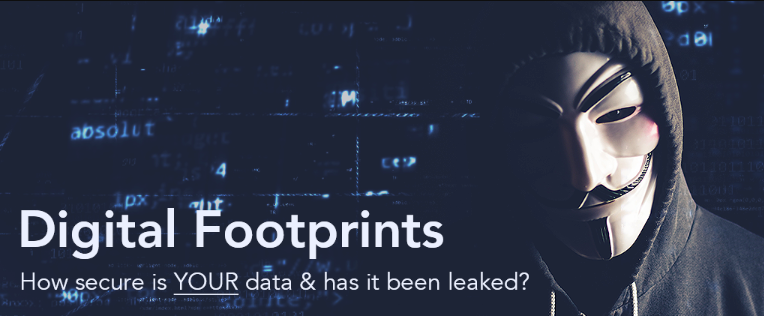In today’s digital world, we all leave behind a digital footprint. It’s the sum total of all the data generated from our online actions, such as social media activity, emails, browsing history, and app usage. Most of us may not realise the underlying threat of our digital footprint that no one is talking about. It’s essential to understand how our digital footprints can be exploited and what we can do to protect them.
There are two primary types of digital footprints, active and passive.
Active Digital Footprint:
When you intentionally provide data online, like when you post a photo on Facebook or send an email, you’re leaving an active digital footprint. This footprint can give an insight into your likes, dislikes, hobbies, and relationships.
Passive Digital Footprint:
Passive digital footprints are data trails you leave behind unintentionally. These could be cookies from websites, location data from your phone, or even data stored in digital documents.

Every day, we create a digital trail of information about ourselves. We might think this information is harmless or that no one would care to look into it. However, the truth is that our digital footprint carries unexpected risks that often go unnoticed.
Unexpected Risks of Leaving a Large Digital Footprint:
The sheer amount of information available about you online might surprise you. Your posts, comments, and photos can paint a comprehensive picture of your life, including your habits, interests, and relationships. This information can be easily exploited by malicious actors for nefarious purposes, such as identity theft, fraud, or even blackmail.
How Your Digital Footprint Can Be Exploited:
Data brokers, advertisers, and cybercriminals can all exploit your digital footprint. Data brokers collect information from various sources, creating comprehensive profiles about individuals, which they then sell. Advertisers use your digital footprint to tailor their advertising to you. Cybercriminals can use your digital footprint to gain access to your personal or financial information and engage in identity theft.


These examples above reflects just a few of the areas that you need to be aware of and understanding the factors that contribute to your digital footprint and how they shape your online persona. By highlighting these key contributors, you can better manage your online presence and safeguard your privacy and reputation.
Failure to manage your digital footprint can result in various consequences that can have a lasting negative impact on both your personal and professional life.
Identity Theft
One of the most significant risks associated with a large, unmanaged digital footprint is identity theft. Cybercriminals can piece together information about you from your digital footprint and use it to impersonate you, apply for credit, or even commit fraud.
Fraud and Scams
Your digital footprint can be used to target you with personalised phishing scams, which are designed to trick you into providing sensitive information. As a result, you may become a victim of financial fraud or other scams.
Damage to Reputation
Your digital footprint can also have a significant impact on your reputation. Embarrassing photos, old social media posts, or other sensitive information can be used against you, potentially damaging your personal and professional reputation.
Your digital footprint is a valuable commodity for several entities, including data brokers, advertisers, and social media platforms.
Data Brokers and Their Role
Data brokers collect and aggregate information from various sources, including public records, social media, and other online platforms, to create detailed profiles about individuals. These profiles can be sold to third parties for various purposes, including targeted advertising, risk assessment, or even law enforcement.
How Advertisers Use Your Digital Footprint
Advertisers can use your digital footprint to gain insight into your preferences, habits, and interests. This information is then used to create targeted ads that are more likely to resonate with you, increasing the likelihood that you’ll engage with the ads.
The Role of Social Media Platforms
Social media platforms also benefit from your digital footprint. These platforms collect information about your activities, including the pages you like, the posts you share, and even the amount of time you spend on the platform. This data is used to create a more personalised experience for you, increasing your engagement and keeping you on the platform longer.

A digital footprint is the data trail left by your online actions, including browsing history, social media activity, emails, and app usage.
Protecting your digital footprint is crucial for preventing identity theft, fraud, and damage to your reputation. Safeguarding your digital footprint can also help you maintain your privacy and prevent your information from being exploited by data brokers and advertisers.
Reducing your digital footprint involves limiting what you share online, regularly reviewing your digital footprint, using privacy settings, deleting old accounts and data, and using tools like VPNs and secure browsers to protect your online activities.
Active digital footprints are created when you intentionally provide data online, like posting on social media or sending an email. Passive digital footprints are data trails you leave behind unintentionally, such as cookies, location data, or data stored in digital documents.
Protecting yourself from identity theft involves monitoring your financial accounts, using strong and unique passwords, keeping your software updated, and managing your digital footprint.
While it may be challenging to delete your digital footprint entirely, you can take steps to minimise your digital footprint by limiting what you share online, regularly reviewing and deleting old data, and using privacy settings and tools to protect your online activities.
Protecting your digital footprint is essential for preventing identity theft, fraud, and other risks associated with a large, unmanaged digital footprint.
Privacy Settings and Their Importance
Most online platforms and services offer privacy settings that allow you to control who can access your information. Regularly reviewing and adjusting these settings can help minimise the amount of information available about you online.
Deleting Old Accounts and Data
Over time, you may accumulate numerous online accounts and data that are no longer relevant or needed. Regularly reviewing your digital footprint and deleting old accounts and data can help reduce the risk of identity theft and other threats.
Using VPNs and Secure Browsing
Virtual Private Networks (VPNs) and secure browsing tools can help protect your digital footprint by encrypting your data and hiding your online activities from prying eyes. This can help prevent data brokers, advertisers, and cybercriminals from collecting information about you.
Identity theft can have long-lasting consequences, including financial losses, damage to your credit score, and even legal issues. Taking steps to prevent identity theft is crucial for protecting your digital footprint.
Monitoring Your Financial Accounts
Regularly reviewing your financial accounts for suspicious activity can help you detect and respond to identity theft quickly.
Using Strong, Unique Passwords
Using strong, unique passwords for your online accounts can help prevent unauthorized access to your accounts and reduce the risk of identity theft.
Keeping Your Software Updated
Keeping your software, including your operating system, web browsers, and apps, up-to-date can help protect your digital footprint by preventing cybercriminals from exploiting vulnerabilities in outdated software.
“Minimising the risks associated with your digital footprint is not just an issue of personal privacy—it’s a matter of safeguarding your identity, reputation, and overall security in an increasingly connected world. An unmanaged digital footprint can expose you to a multitude of risks, ranging from identity theft and fraud to the misuse of your personal information by third parties. Additionally, a poorly managed digital footprint can have long-lasting consequences for your professional reputation, making it difficult to establish trust with colleagues, employers, and clients. In an age where the lines between our offline and online lives are continually blurring, it’s critical to take proactive steps to protect your digital footprint, reduce potential risks, and maintain control over your online persona.”
– NanoTech Security
Your digital reputation is essential for both your personal and professional life. A few simple tips can help you safeguard your digital reputation.
Limiting What You Share Online
Think twice before you post something online. Once something is shared on the internet, it can be challenging to remove. It’s essential to consider the potential long-term impact of your online actions.
Regularly Reviewing Your Digital Footprint
Take time to review your digital footprint regularly. Check your social media profiles, blogs, forum posts, and other online platforms where you may have left a digital trail. Remove or modify anything that could harm your digital reputation.
Handling Negative Content and Reviews
It’s essential to handle negative content or reviews in a calm, professional manner. If you encounter something damaging to your reputation, consider addressing it constructively or seeking legal advice if necessary.

In conclusion, the underlying threat of your digital footprint no one is talking about can have significant consequences for your personal and professional life. It’s crucial to understand the risks associated with an unmanaged digital footprint and take steps to safeguard your digital reputation. By limiting what you share online, regularly reviewing your digital footprint, and using tools to protect your online activities, you can reduce the risk of identity theft, fraud, and damage to your reputation.